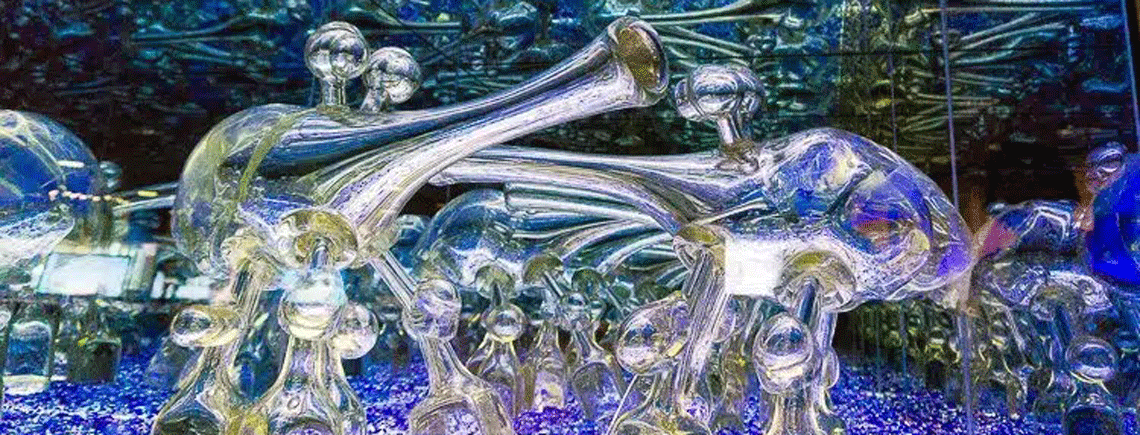Corning Glass At the Clark
Exhibit and Pop-Up
Consider the fragility of glass and the mortality it faces in the hands of careless humans. Its survival is almost as amazing as its creation. Now some of the most stunning pieces found in the Corning Museum of Glass are on view at the Clark Art Institute in an exhibit titled Fragile Beauty: Treasures from the Corning Museum of Glass.
Drawn from the vast collection of the Corning Museum of Glass in Corning NY Fragile Beauty demonstrates how makers from across time and around the globe have taken inspiration from the natural world to create works of art.
Corning has some of the earliest known glass objects, beads that may—or may not—date from before 1500 BCE. Corning glass experts know that many pieces of their earliest glass objects date to the Late Bronze age (1500-1200 BCE) but during those three centuries styles did not change much.
What is known is that for thousands of years, glassmakers have combined sand, minerals, heat and air to create utilitarian and decorative objects. Fragile Beauty demonstrates how makers from across time and around the globe have taken inspiration from plants, animals and other aspects of nature to create dazzling objects.
“The Corning Museum has an amazing collection,” said Kathleen Morris, Sylvia and Leonard Marx director of Collections and Exhibitions, “so when we decided to do an exhibition of glass, I knew we needed to have some kind of commonality between things. There was no way it could be a survey of glass—there’s not enough space. What seemed to me to make great sense and to be a perfect fit, was a focus on glass inspired in a direct way by nature. Every piece has a natural form or is decorated with flora and fauna—or both.”
She had decided on her direction but now came the hard part, selecting from the 50,000 pieces in the Corning collection. “I had the opportunity to go through their galleries and storage looking for things. I wanted things from across time with a broad range of function. I made a list, took pictures and came back and constructed dream list of objects. Then I had to make sure the different items could travel.
“It is astonishing to think that these things survived,” she continued. “They are fragile. The Corning Museum staff packed and transported them. They have experts who know how to protect glass so there is no pressure on fragile areas. It’s a very methodical and painstaking process.”
The result is an exhibit that displays some 28 objects or pairs ranging in time from antiquity to the present and demonstrating a remarkable breadth of color, technique, form and function. Some of these objects were made for practical use, such as drinking glasses, vases, and pitchers. Others are purely decorative from a life-size lemon to a giant flower.
Highlights of the selection include glass from the legendary Venetian island of Murano; enameled glass made in early modern Europe and India; objects blown, cut, carved, assembled and otherwise crafted with astonishingly varied techniques; Art Nouveau glass by artists including Louis Comfort Tiffany, René Lalique, and Steuben; and works by contemporary American and Asian glass artists. They are all displayed in the light-filled space of the Clark’s Michael Conforti Pavilion.
From August 5th through 11th, visitors will also be able to see glass-blowing demonstrations by expert glass blowers from Corning who travel with the facility’s Mobile Hot Shop. Every day from 10AM to 5P the Hot Shop will offer free glassblowing demonstrations.
While Morris says techniques have been refined over the millennia, the demonstrations will introduce visitors to a process whose basics date back to the late Bronze Age. “Over time, different glass artists have experimented and found new formulas,” Morris said. “There have been a lot of technological advances. Some techniques used do not have the same outcome, but blowing through a pipe—that is just the same as always.”
Will Schmenner, the Clark’s head of public programs, said the Hot Shop is “an amazing contraption that unfolds to create a stage to give all these wonderful performances.” Totally mobile, it has traveled internationally as far away as Australia to introduce the public to the techniques of creating glass objects.
“They can do almost anything you can imagine, given their limited time,” Schmenner said. “They talk about the science of glass and they have a program where you draw it, they make it. They have children make drawings and then they choose one and make it after the child’s drawing.” Each show lasts about 45 minutes to an hour.
The Clark Art Institute is located at 225 South Street in Williamstown. For information on these programs and more, visit clarkart.edu or call 413 458 2303.


